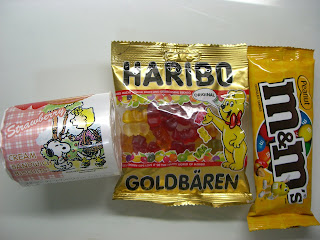2007年4月15日日曜日
2007年4月12日木曜日
Label of Sake



These whiskies are made by a company, SUNTORY. These labels are written in all English except for one label. There are many kinds of bottle style. Bottles in the middle picture are miniture bottles, about 100ml.
I think the reason why these labels are written in English is that whiskey came from foreign country so image of whisky is probably foreign style.
These whiskies are from foreign country. By comparing to Japanese whisky, there are some analogy. Each bottle style is unique and label is written in English. I feel Japanese whisky company borrows these styles to keep image of whisky.
One of unique bottles made by SANTORY.


They are nihonshu and shochu. Nihonshu and shochu are traditional sake in Japan. All of these are written in kanji and hiragana like a Japanese-style confection. Almost all of these labels are written with writing blush-style font. Bottle styles are generally the same: 1.8L, 900ml and 720ml are general bottle style.
Although it depends on a company, the back of nihonshu usually has information which includes the process of making, introduction of how to drink, company name, method of preservation and message which says that the age under 20 must not drink and please recycle this bottle. Although some nihonshu labels don't have information on the back, they do have necessary information like ingredients, on the front label.

They are nihonshu bottles and are sold for people who want to drink little like beer cans. The capacity is from 180ml to 720ml.

They are shochu. The bottle of shochu have many styles, even if it was the same commodity. The first shochu to the left has earthen ware-style bottle, Toki bottle in Japanese. It shows Japanese tradition.
They are unique bottles. The left thing is a sake barrel. The right one is a sake bottle which represents a zodiac sign or animal sign. They are nihonshu and mainly sold on January to congratulate a New Year.
2007年4月11日水曜日
Label of Snacks




These snacks, Koara No March, Pockey, and Meiji Milk Chocolate are very common in Japan. The label has not changed for few decades.. They have a simple label style which only has the name of the snack written on it.
On the back of the packaging, the following information can be found: The advertising slogan, campaign, general name, ingrediants, weight, storage instructions, company name and its address, website address, information which specific ingrediants are made from the company's branches, and introductions of how to provide feedback or make complaints if the product is found faulty/unsatisfactory - there is a lot of written information.
In general, bar code is put on where we can't see in the face of package. I mean it is written on the back or side.
What is unique about the advertising on these sweets/snacks compared to Japanese-style confection is the title which is written both in katakana and English.



These are Japanese-style confection, Senbei and Surume made from squid. The label of Senbei has a bold design, which has gold coloring. The back of the packaging has the same content as the snacks above. Labelling of Surume is simple. A particular feature of the label is that it is written in kanji and hiragana with writing brush-style font.

Sakuma Drop is also a famous product in Japan. In the can, there are many candies with a variety of fruit flavours. This type of confectionary has been sold for a long time, it is rare that candy is sold in this style of packaging these days. Confectionary is sold usually wrapped in a bag-type package.

This is a chocolate from Morinaga. This is like image of melting chocholate. The reason this label uses gold color is to be looked gorgeous. Also this label is so simple that only has commodity name and company logo. This simpleness makes this look gorgeous.
登録:
投稿 (Atom)






